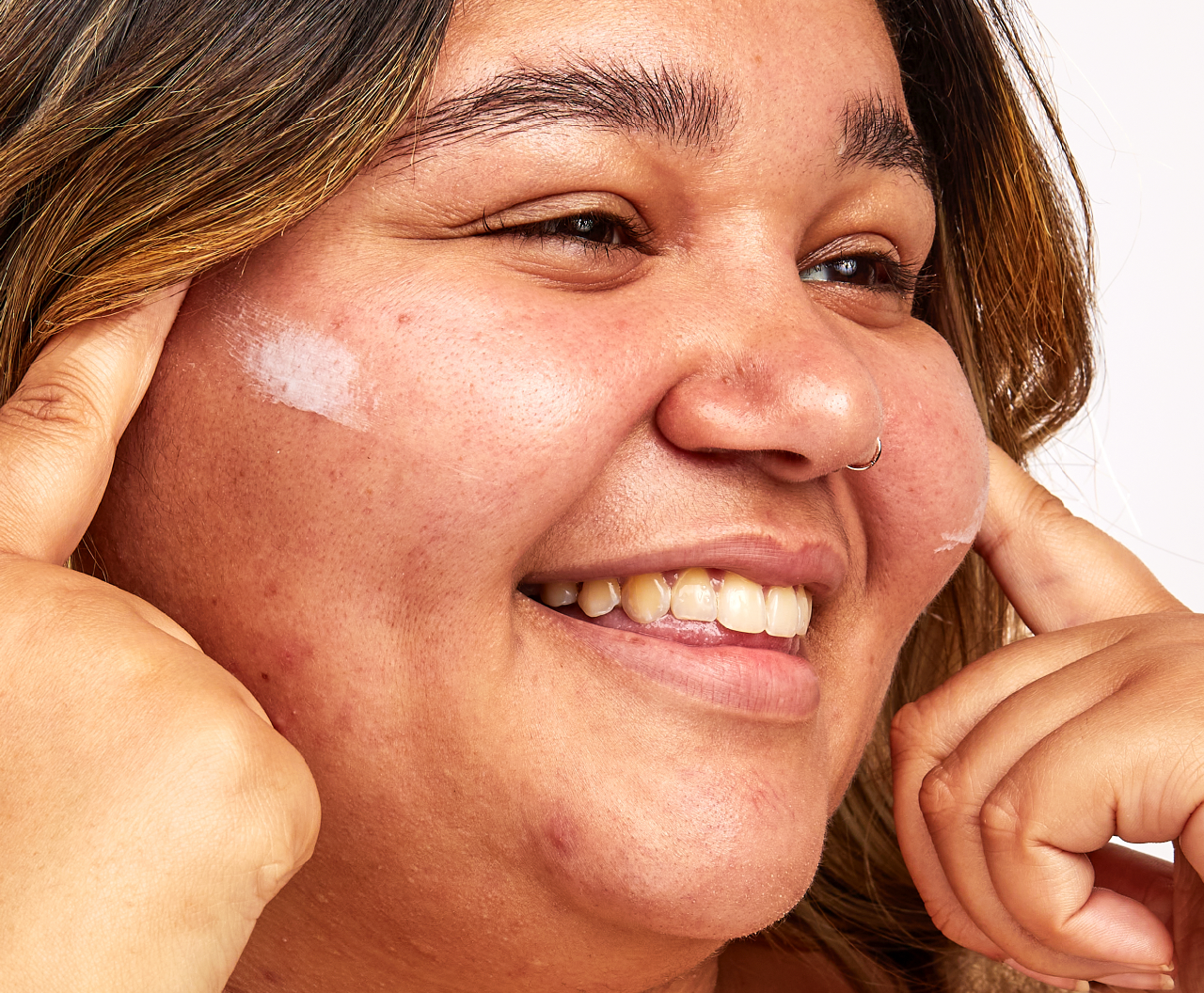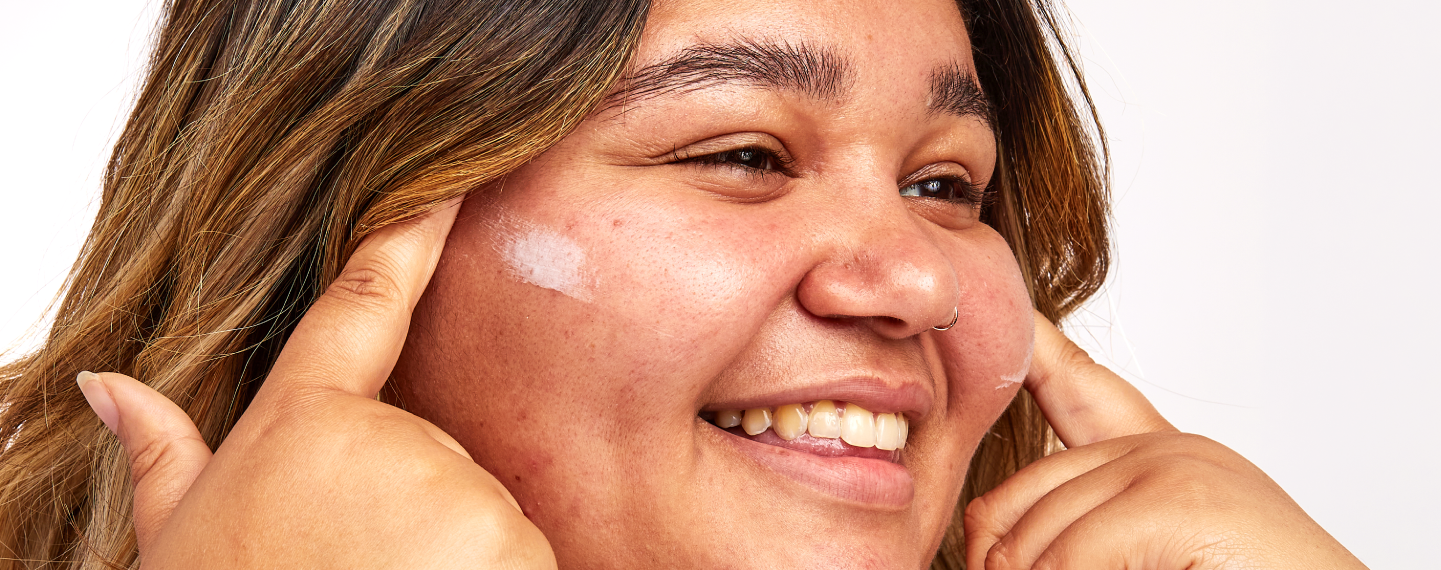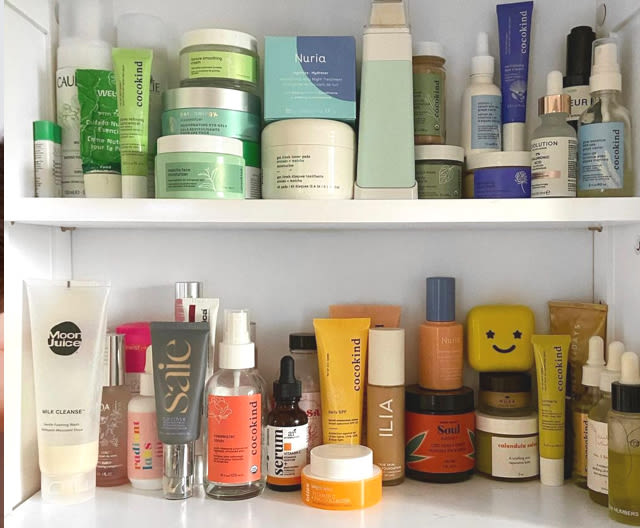Education
Baking soda for acne: Is it effective?


SHARE
Education
Baking soda for acne: Is it effective?
Medically reviewed by Kristin Hall, FNP
Written by Apostrophe Team
Last updated 4/1/2024
From the occasional pimple to severe, persistent breakouts, acne can be a serious issue that affects both your appearance and your self-confidence.
If you’ve searched online for information about home remedies for acne, you might have seen baking soda, or sodium bicarbonate, mentioned alongside other popular natural treatments.
While baking soda does have some medicinal effects -- for example, it’s a natural antacid that’s quite helpful for treating heartburn -- there’s currently no scientific evidence that it can get rid of acne, prevent breakouts, or do anything else to improve your skin.
In fact, many healthcare professionals advise against using baking soda for skin care due to its tendency to dry out your skin and affect its protective barrier.
Below, we’ve dug into the science behind acne breakouts and baking soda to help you find out more about this popular cooking ingredient’s skin care effects.
We’ve also explained what you can do if you’re prone to acne breakouts and want to get rid of your pimples and prevent them from coming back.
Baking Soda & Acne: The Basics
Acne breakouts occur when substances like sebum and dead skin cells cause your hair follicles to become blocked, or plugged.
A variety of factors, such as your hormones, genetics, and skin care habits can influence your likelihood of developing acne.
Most acne treatments work by reducing sebum levels, stripping away dead skin cells, or killing the bacteria that can grow inside red, inflamed acne lesions.
Currently, there’s no scientific evidence that baking soda is effective at getting rid of acne or preventing breakouts.
Because baking soda is naturally alkaline, it can dry out your skin and lead to irritation if it’s applied for too long.
How & Why Acne Develops
Acne develops when your hair follicles, or pores, become blocked by a combination of sebum and dead skin cells.
Sebum is a type of oil that’s produced by your skin. It’s secreted by your sebaceous glands and plays a major role in lubricating your skin and maintaining its protective barrier against damage from the environment, bacteria, viruses, and fungi.
Your skin releases sebum via the hair canal. Although a certain amount of sebum is important for maintaining your skin, when your skin produces too much sebum, the extra oil can become trapped inside the hair follicle, causing a blockage.
In addition to sebum, your skin is constantly producing new cells through a process referred to as epidermal turnover.
To keep your skin strong and healthy, new cells are created in the basal layers of your skin to replace old ones. Over the course of 40 to 56 days, these cells travel from the basal layers of your skin to the epidermis, replacing old, worn out skin cells in the process.
Over time, the dead skin cells left behind by your body’s epidermal turnover process can build up on the surface of your skin and contribute to blocked hair follicles.
A variety of different factors play a role in this process, including your genetics and your body’s production of certain sex hormones. We’ve talked about these more in our guide to the causes of acne.
Finally, bacteria, which constantly grow on your skin, can become trapped inside blocked hair follicles. When this happens, acne can worsen from non-inflamed comedones to red, inflamed, and painful papules, pustules, and nodular or cystic acne.
Because acne is all about sebum, dead skin cells, and bacteria, most treatments for acne work in one of four ways:
By washing away sebum that’s already on your skin
By stripping away dead skin cells that are already on your skin, or by speeding up your body’s production of new skin cells to replace old, dead ones
By reducing your body’s sebum production (for example, by reducing levels of hormones that stimulate your sebaceous glands to secrete sebum)
By killing or controlling the bacteria that cause inflamed, infected acne
Most topical acne treatments work by washing away sebum and/or dead skin cells. Antibiotics, such as clindamycin, work by killing the bacteria that can grow inside acne lesions and cause them to become inflamed and painful.
Some oral medications, such as the birth control pill, work by reducing your production of sex hormones that regulate sebum production.
Does Baking Soda Treat Acne?
Right now, there’s no scientific research showing that sodium bicarbonate, or baking soda, is an effective treatment for acne.
There’s also no scientific research showing that baking soda controls sebum, dead skin cells, or any of the other factors that can contribute to blocked hair follicles.
Although some studies have found that baking soda may possess mild antibacterial effects, the research that’s available now isn’t very comprehensive, with no studies that look specifically at the effects of baking soda on bacterial growth on the skin.
In short, right now there isn’t any scientific evidence to show that baking soda has any effect on acne breakouts.
Baking Soda Safety & Side Effects
Baking soda is a moderately alkaline substance, or base. Its pH is between 8.3 and 9.5, which is significantly higher than the pH of approximately 4.7, which is your skin’s average.
To put these numbers in perspective, any substance with a pH of zero to six is acidic, while a pH in the eight to 14 range indicates that a substance is alkaline.
For example, a powerful acid like battery acid or hydrochloric acid has a pH of zero, while a strong alkaline substance such as liquid drain cleaner has a pH of 14. Your blood has a neutral pH of 7.4, respectively.
While the idea that your skin is slightly acidic might sound strange, your skin’s acidity plays an important role in its job as a protective barrier against bacteria and other potentially dangerous microorganisms.
By applying baking soda to your skin, you may raise your skin’s average pH and cause issues such as dryness, inflammation, and increased sensitivity. Increasing your skin’s pH in this way may also increase your risk of developing acne.
Because of these risks, it’s best not to apply baking soda or at-home treatments that are made with baking soda to your skin.
Science-Backed Treatments for Acne
Although there’s no evidence that baking soda treats acne, several science-backed products and medications are proven to get rid of acne lesions and prevent breakouts.
Some of these treatments are available over the counter from your local drugstore, while others are only available with a prescription.
Over-the-Counter Products
Mild to moderate acne can often be treated using over-the-counter products such as cleansers and non-prescription medications. Options include:
Benzoyl peroxide. A common ingredient in cleansers, benzoyl peroxide works by killing the bacteria that can contribute to inflamed acne. It also has mild effects against sebum and dead skin cells that can clog pores and cause acne breakouts. Our guide to benzoyl peroxide for acne goes into more detail about how this ingredient works, its benefits, side effects, and more.
Over-the-counter retinoids. Retinoids such as retinol and adapalene are effective at treating acne breakouts. In fact, dermatologists consistently recommend retinoids as a first-line treatment for people prone to acne. Although stronger retinoids like tretinoin are only available with a prescription, retinol, and low-concentration adapalene (available as Differin®) are both available over the counter from most drugstores.
Prescription Medications
If you have moderate to severe acne, or if over-the-counter acne treatments don’t produce the results you’d like, you may need to use prescription medication to get your acne under control and prevent new breakouts from occurring in the future.
Several science-based prescription medications are available to treat acne. Options include:
Tretinoin. Tretinoin is a topical retinoid that speeds up your body’s production of new skin cells, reducing your risk of acne breakouts. It’s an ingredient that could be in your Apostrophe topical treatment. Our guide to tretinoin for hormonal acne explains how tretinoin works and how you can use it as part of your acne prevention routine.

PRESCRIPTION TRETINOIN
Target acne, dark spots, and signs of aging with this science-backed ingredient.
Hormonal birth control. Some forms of the combination birth control pill are approved by the FDA as acne treatments. These work by reducing your production of hormones that can contribute to sebum production and acne breakouts.
Isotretinoin. Isotretinoin is a powerful medication that’s used to treat severe acne. Although it’s highly effective, it can cause side effects, requiring you to keep in regular contact with your dermatologist during treatment.
In Conclusion
Although baking soda can be helpful for treating heartburn or removing plaque from your teeth, there’s no evidence that it treats or prevents acne.
In fact, because baking soda is slightly alkaline, applying it to your skin could affect your skin’s pH and cause issues such as dryness and irritation.
If you have acne, you’ll get significantly better results from science-based medications than you will from baking soda. You can get started by talking to a licensed healthcare provider online to learn more about the best options for treating acne and keeping your skin healthy.
References:
Hoover, E., Aslam, S. & Krishnamurthy, K. (2020, October 26). Physiology, Sebaceous Glands. StatPearls. Retrieved from https://www.ncbi.nlm.nih.gov/books/NBK499819/
Koster, M.I. (2009, July). Making an epidermis. Annals of the New York Academy of Sciences. 1170, 7-10. Retrieved from https://www.ncbi.nlm.nih.gov/pmc/articles/PMC2861991/
Acne. (n.d.). Retrieved from https://www.americanskin.org/resource/acne.php
Drake, D. (1996). Antibacterial activity of baking soda. Compendium of Continuing Education in Dentistry. 17 (19), S17-21. Retrieved from https://pubmed.ncbi.nlm.nih.gov/11524862/
Corral, L.G., Post, L.S. & Montville, T.J. (1988, May). Antimicrobial Activity of Sodium Bicarbonate. Journal of Food Science. 53 (3), 981-982. Retrieved from https://onlinelibrary.wiley.com/doi/abs/10.1111/j.1365-2621.1988.tb09005.x
Sodium bicarbonate. (2021). Retrieved from https://pubchem.ncbi.nlm.nih.gov/compound/Sodium-bicarbonate
Lambers, H., Piessens, S., Bloem, A., Pronk, H. & Finkel, P. (2006, October). Natural skin surface pH is on average below 5, which is beneficial for its resident flora. International Journal of Cosmetic Science. 28 (5), 359-70. Retrieved from https://pubmed.ncbi.nlm.nih.gov/18489300/
Surber, C., Abels, C. & Maibach, H. (2018). pH of the Skin: Issues and Challenges. Current Problems in Dermatology. 54, 115-122. Retrieved from https://www.karger.com/Article/Abstract/489525
Prakash, C., Bhargava, P., Tiwari, S., Majumdar, B. & Bhargava, R.K. (2017, July). Skin Surface pH in Acne Vulgaris: Insights from an Observational Study and Review of the Literature. Journal of Clinical and Aesthetic Dermatology. 10 (7), 33–39. Retrieved from https://www.ncbi.nlm.nih.gov/pmc/articles/PMC5605222/
Matin, T. & Goodman, M.B. (2020, November 24). Benzoyl Peroxide. StatPearls. Retrieved from https://www.ncbi.nlm.nih.gov/books/NBK537220/
Leyden, J., Stein-Gold, L. & Weiss, J. (2017, September). Why Topical Retinoids Are Mainstay of Therapy for Acne. Dermatology and Therapy. 7 (3), 293–304. Retrieved from https://www.ncbi.nlm.nih.gov/pmc/articles/PMC5574737/
Trivedi, M. K., Shinkai, K., & Murase, J. E. (2017). A Review of hormone-based therapies to treat adult acne vulgaris in women. International journal of women's dermatology, 3(1), 44–52. https://www.ncbi.nlm.nih.gov/pmc/articles/PMC5419026/
Kraft, J., & Freiman, A. (2011). Management of acne. CMAJ : Canadian Medical Association journal, 183(7), E430–E435. Retrieved from https://www.ncbi.nlm.nih.gov/pmc/articles/PMC3080563/
Like what you just read? Sign up for our email list to get the scoop on skincare science delivered straight to your inbox.

Education
What is milia?
What is milia? Today, we’re jumping into one type of bump that you may have heard about most commonly in infants — milia.
Read More
Education
Best moisturizer for acne-prone skin
If you have combination acne-prone skin, figuring out which moisturizer is best for your skin might be tough. In this guide, we break down the best moisturizer for combination, acne-prone skin.
Read More
Education
How to build a face care routine
As you get into skincare, it might seem overwhelming, especially trying to figure out the order you're supposed to apply products in. Below, we detail how to build a face care routine for your skin!
Read More